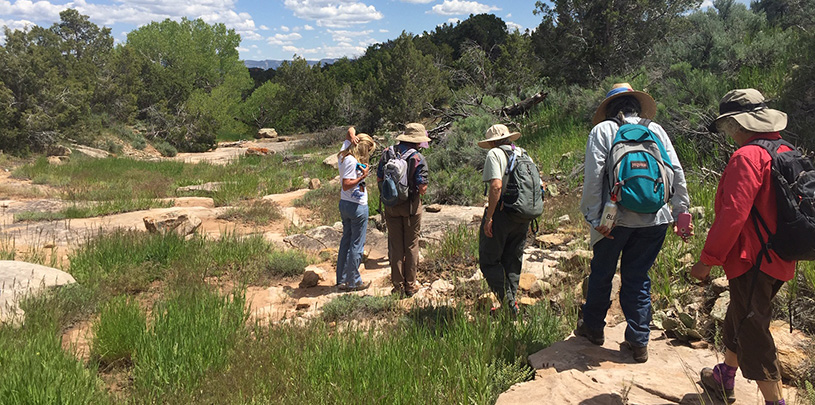
By Audrey Kruse, Trust Community Engagement Director and Mike Kruse, Grassroots Leadership Coordinator for Great Old Broads
“When I looked out at this landscape two days ago, I thought, wow! It looks so healthy! There is green grass growing between the sage and it looks lush. Now that I’ve done this training, my whole perspective has changed!” says Robyn Cascade as she squints at a field of verdant but non-native grasses.
Over the course of three days, Robyn and the other volunteers, have learned how to “read” the terrain — looking for important clues, like the presence of non-native plants, that indicate a cow-munched landscape. Our public lands in the West host large numbers of cattle, and they have for a long time. Most of us, like Robyn, are accustomed to seeing barren, stripped, and overgrazed landscapes. But with a little training, we can start to see the land for what it is and reimagine what our public lands can look like with fewer cattle.
The Trust wants to understand how cattle grazing impacts the plants, animals, soils, and waters across the Colorado Plateau. Where Cows Don’t Graze is an initiative the Trust launched in 2018 to identify and study non-grazed areas on the Colorado Plateau (no easy task!) and compare the conditions of those cattle-free lands to grazed ones. To do that, we need boots on the ground. Lots of boots. So we’re training volunteers to help us collect data on a much larger scale than our staff can hope to accomplish alone.
“Yoohoo!” A feisty shout from one volunteer echoes across the livestock-free land in Canyons of the Ancients National Monument, signaling the rest of the group to gather ‘round. Robyn and her fellow volunteers are Great Old Broads. We’re not being sassy — the Great Old Broads for Wilderness is a national grassroots organization led by women, with 40 chapters (called Broadbands) around the country working to protect and preserve public and wild lands. This week, they’re partnering with the Trust and bringing their astute eyes to the Where Cows Don’t Graze project.

Biological soil crusts are the arid land version of green leaves spread out on the ground, as the lichen and mosses snag sunlight, water, and carbon dioxide to make food for those around them.
The group clusters around a patch of soil crust perched atop a pedestal a few inches above the surrounding sand. When cows trample the landscape, they destroy delicate soil crusts like this that help hold down the fine, sandy soil. This, in turn, makes it harder for plants to establish — bad news for the insects, birds, and mammals that depend on them. The women lean in closer to snap photos of the crust and record their observations.
Broads like Robyn Cascade, the leader for the Northern San Juan Broadband in Colorado, work on an array of projects on public lands, from documenting grazing impacts, to commenting on forest management plans, to lobbying at our nation’s capital for our wild places. We’re grateful to have partners like the Broads who work with us and use their voices to amplify the Trust’s priorities and advocate for less grazing on the Colorado Plateau.

So far, we’ve trained about 40 volunteers (15 of which are Broads), to observe grazed and ungrazed lands. Now equipped with critical eyes, we’re sending them out on their own (preferably with a friend or fellow Broad), to help us collect data.
Our citizen scientists visit pairs of sites — one cattle-free, the other grazed — to document conditions of the land. We’ll use their photos and observations to create a database and map of areas closed to livestock grazing. Ultimately, this will help us visualize, advocate, and tell the story of the impacts cattle have on our public lands.
READ: Cowtography: Mapping Where Cows Don't Graze ›
Through projects such as Where Cows Don’t Graze, volunteers have the opportunity to see the potential of our public lands when released from the unrelenting pressure of cattle grazing. Science has shown that overgrazing on our Western lands impacts all living things, from the bacteria in the soil, to the sage grouse who need protective cover of native plants, to the aspen sprouts that are struggling to take root.
As 2024 draws to a close, we look back at five maps we created this year that give us hope for 2025.
Read MoreThe federal government will determine if the charismatic blue bird should be listed as threatened or endangered.
Read MoreWe can’t wait to meet you in a canyon, along a creek, or in the high alpine meadows of the Colorado Plateau.
Read More